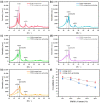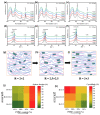Crystallinity and β Phase Fraction of PVDF in Biaxially Stretched PVDF/PMMA Films
- PMID: 33805093
- PMCID: PMC8037939
- DOI: 10.3390/polym13070998
Crystallinity and β Phase Fraction of PVDF in Biaxially Stretched PVDF/PMMA Films
Abstract
Polyvinylidene fluoride (PVDF) and poly(methyl methacrylate) (PMMA) blend films were prepared using biaxial stretching. The effects of PMMA content and stretching ratio on the crystallinity and β phase fraction of PVDF in blend films were investigated. The distributions of crystallinity and β phase fraction on variable locations were also studied. The results of FTIR and XRD showed that β phase appeared in PVDF/PMMA blends after extrusion and casting procedures. Although β phase fraction decreased after preheating, there was still an increasing trend during following biaxial stretching. More importantly, the increase in PMMA content improved β phase fraction, and the highest β phase fraction of 93% was achieved at PMMA content of 30 wt% and stretching ratio of 2×2. Besides, the reduction in PMMA content and the increase in stretching ratio improved the crystallinity of PVDF. The mechanical properties of the stretched films were significantly improved by increasing the stretching ratio as well. The uniform stress distribution on different regions of biaxial stretching films contributed to the uniform distribution of β phase fraction and crystallinity of PVDF with the aid of simulation. This work confirmed that biaxial stretching can be a candidate method to prepare PVDF/PMMA blend films with uniform distributions of comparable β phase and crystallinity of PVDF.
Keywords: PMMA; PVDF; biaxial stretching; crystallinity; thermo-mechanical fields; β phase.
Conflict of interest statement
The authors declare no conflict of interest.
Figures








References
-
- Salimi A., Yousefi A.A. FTIR studies of β-phase crystal formation in stretched PVDF films. Polym. Test. 2003;22:699–704. doi: 10.1016/S0142-9418(03)00003-5. - DOI
Grants and funding
LinkOut - more resources
Full Text Sources
Other Literature Sources

